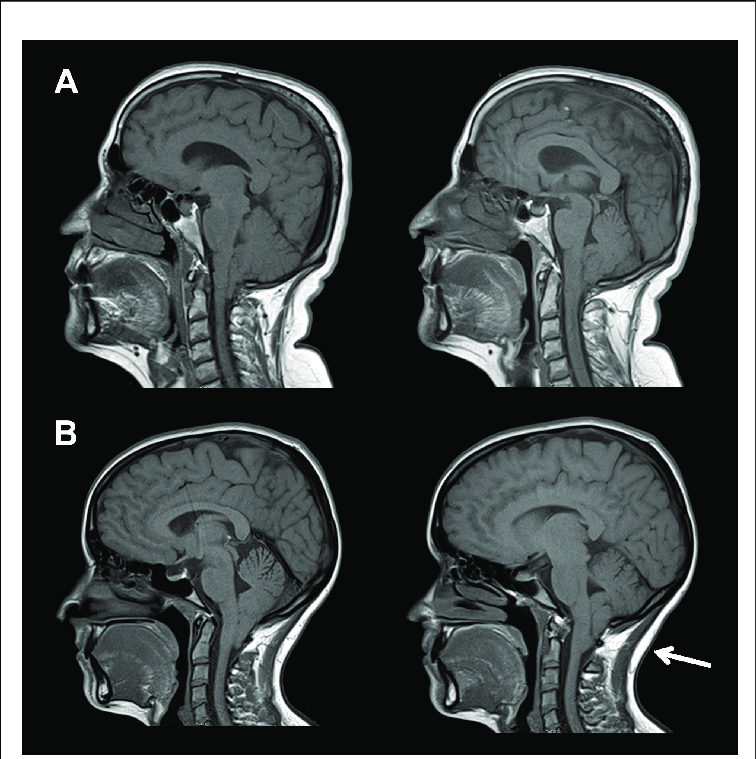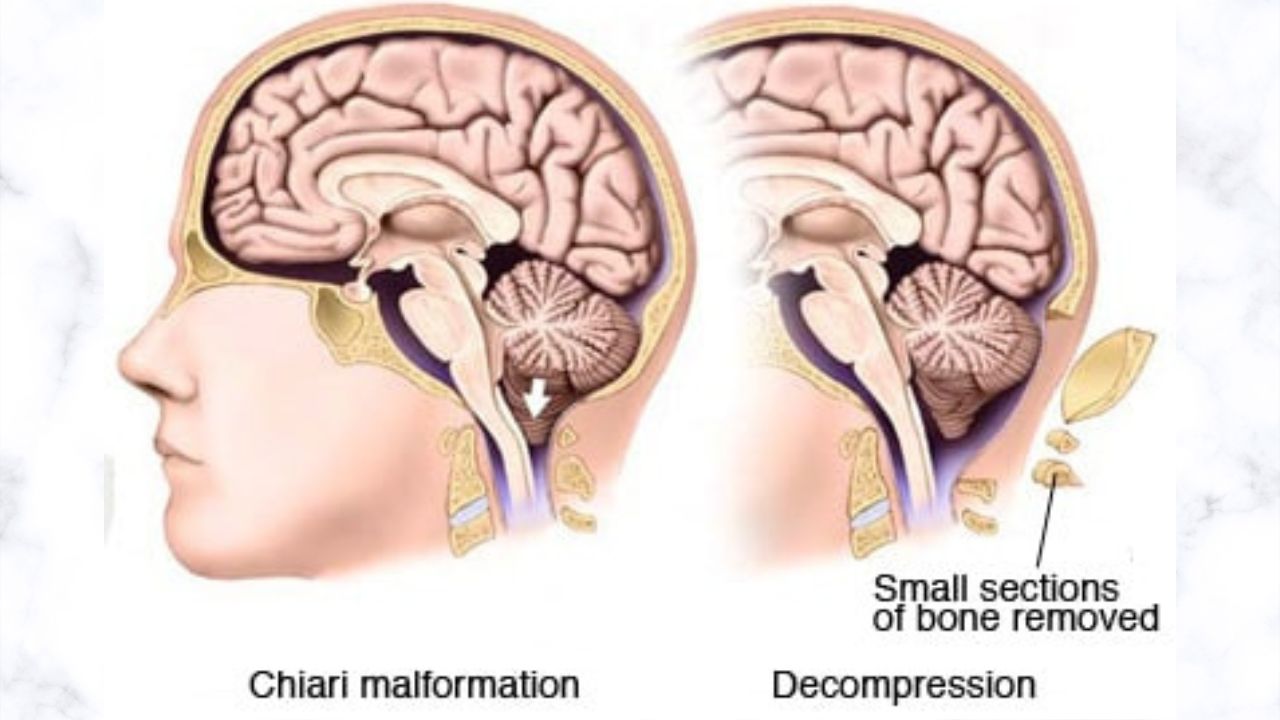Chiari malformation type 1 is a disease in which a small portion of the back of the brain descends into the spinal column, where it can impede the flow of cerebrospinal fluid. Symptoms of the disorder, which can be progressive and disabling, usually do not appear until late childhood or early adolescence.
Chiari malformation type 1 is usually treated with surgery that restores the free flow of cerebrospinal fluid by providing more space in the back of the brain.
Chiari malformation type 1 icd 10 : Q07.0
What is Chiari malformation type 1?
Chiari malformation type I is a condition where the cerebellum, the part of the brain that controls muscle movement and coordination, descends through a hole in the base of the skull. This hole is called the “foramen magnum.” Through its interior, only the spinal cord usually passes.
Many children with type I Chiari malformation do not have any symptoms. Treatment can help children who do have symptoms.
What is Chiari malformation
The thick bundle of nerves that connects the brain to the spinal cord passes through a funnel-like hole at the base of the skull called the foramen magnum. Cerebrospinal fluid, which feeds, maintains, and protects the brain, also flows through the foramen magnum to the lower parts of the central nervous system.
Just above the foramen magnum is an area of the skull called the posterior fossa, which supports the cerebellum, the part of the brain that regulates balance and coordination. If the posterior fossa is too small, small, extended pieces of the cerebellum, called the cerebellar tonsils, may be pushed down and past the foramen magnum into the spinal column.
What are the signs and symptoms of Chiari malformation type I?
Although the cranial defect that causes type 1 Chiari malformation may be present before birth, symptoms usually take years to appear. Common symptoms include pain in the back of the head that worsens with exertion, dizziness, difficulty swallowing, loss of coordination and fine motor skills, depression, muscle weakness, fatigue, and numbness in the hands, arms, or legs.
Sometimes patients also experience problems with balance, sleep, hearing, and vision. Symptoms vary from patient to patient, and can change over time depending on the intensity and location of the pressure points.
When brain tissue blocks the flow of cerebrospinal fluid, a differential pressure between the skull and the spine can cause a hammer-like effect, similar to shock waves knocking over water pipes when the flow is turned on and off rapidly. These pressure waves can cause a type of cerebrospinal fluid-filled cyst called a syrinx to form in the central canal of the spinal cord.
Since many symptoms of type 1 Chiari malformation are also associated with other disorders, it can be difficult to identify the disease. The diagnosis of Chiari malformation begins with X-rays of the bone abnormalities that underlie Chiari malformation type 1 and an MRI showing the cerebellar tonsils descending into the spinal column.

Many children affected by type I Chiari malformation never develop symptoms. In the event that this malformation does cause symptoms, these usually do not appear until late childhood or adolescence.
Signs and symptoms include:
- Headaches (especially after coughing, sneezing, or straining)
- Balance problems
- Neck Pain
- Dizziness
- Vision problems
- Poor hand coordination
- Numbness and tingling in the hands and feet
- Change in the habits of urinating (peeing) or defecating (pooping)
- Swallowing difficulties
- Hoarseness.
Children with type I Chiari malformation sometimes also have:
- Syringomyelia: accumulation of cerebrospinal fluid within the spinal cord
- Hydrocephalus : accumulation of cerebrospinal fluid in spaces deep within the brain
- Sleep apnea: brief periods that occur during sleep when the child stops breathing
- Scoliosis : excessive curvature of the spine.
Symptoms
| Symptom | Freq. absolute(n) | Freq. relative (%) |
| Headaches | 52 | 90 |
| Cervical pain/ contracture | 25 | 43 |
| Nausea with headache | 30 | 51 |
| Vomiting | 7 | 12 |
| Isolated vertigo | 1 | 1.8 |
| Vertigo with previous headache | twenty-one | 36 |
| Swallowing disorder | 5 | 8.5 |
| Dysphonia | two | 3.6 |
| Short neck (basilar imp) | 3 | 5 |
| Spinal motor deficit | 6 | 10.5 |
| Sensory disorders | 5 | 8.5 |
Causes of Chiari malformation type I
There are four different types of Chiari malformation (I, II, III, and IV). Type I is the most frequent.
Doctors don’t know exactly what causes Chiari malformation type I. A baby can be born with this malformation or develop it during the first years of life. Less commonly, this malformation can occur later as a result of trauma, infection, or other medical problems.
Chiari type I malformation can run in families. Therefore, it may be genetically based.
Chiari malformation type I occurs when the space occupied by the cerebellum is smaller than normal or has an odd shape. This causes part of the cerebellum to compress downward as it passes through the foramen magnum. If this compression puts pressure on the cerebellum and spinal cord, it can lead to symptoms.
Frequency
Chiari malformation type 1 is not common; it is diagnosed in fewer than 1 in 1,000 children. However, the cranial abnormality that leads to the condition may be more common than the diagnosis suggests. If brain tissue descends through the foramen magnum in such a way that it does not damage brain tissue or significantly obstruct the flow of cerebrospinal fluid, the abnormality itself may never be diagnosed. In other words, many cases of type 1 Chiari malformation may be asymptomatic, or the symptoms may never be severe enough to prompt a diagnosis. However, in most cases, the symptoms gradually worsen and, if left untreated, will become debilitating.
Previously considered an intractable and progressive disorder, type 1 Chiari malformation can now be effectively treated with surgery to create more space for the cerebellum and restore the flow of cerebrospinal fluid from the skull to the spine.
How is Chiari malformation type I diagnosed?
Chiari malformation type I usually does not cause symptoms. As a result, many cases go undetected until brain or spinal cord imaging is performed for another reason.
How is Chiari malformation type I treated?
In children who do not present symptoms, doctors usually recommend follow-up through magnetic resonance imaging or MRI to review any possible changes that may occur. Surgery is usually not necessary.
When the child has severe symptoms, doctors often recommend a surgical procedure called posterior fossa decompression. This procedure expands the space that the cerebellum can occupy and reduces the pressure placed on the spinal cord.
Children with associated problems (such as syringomyelia, hydrocephalus, sleep apnea, or scoliosis) may require medical treatment of these conditions.
Some doctors recommend that children with type I Chiari malformation avoid certain activities, such as gymnastics, wrestling, and contact sports.
Chiari malformation type 1 surgery
Surgery for chiari malformation type 1 is called posterior fossa decompression surgery, or sometimes just Chiari decompression. It begins with the removal of a portion of the skull bone (craniotomy) at the bottom of the back of the skull to relieve pressure from the herniated cerebellum and restore the unimpeded flow of cerebrospinal fluid. The surgeon then removes a part of the arched bony roof of the spinal canal, called C1, to make more room and relieve pressure on the spinal cord.
Sometimes the surgeon will then round the cerebellar tonsils to further improve cerebrospinal fluid flow. Finally, with a microscope, The surgeon sews a flexible, durable patch over the area to protect the underlying tissue while allowing space for the cerebellar tonsils and aiding the free flow of cerebrospinal fluid. The surgery normally takes two to three hours.
Most children who have Chiari decompression surgery notice an improvement in their symptoms one to two weeks after surgery. Although most children only need surgery to correct their chiari malformation type 1, some children require subsequent surgical procedures to treat their Chiari malformation type 1. In very young children, for example, the removed bone may grow back and compress the cerebellum again, or the lower portions of the cerebellum may fall back below the foramen magnum and impede the flow of cerebrospinal fluid.
The syrinx may also reform, requiring surgical treatment with another Chiari decompression or installation of a syrinx shunt. The goal of surgery is to maximize the child’s quality of life so that he can be a child again.
What can parents do?
Many children with type I Chiari malformation never develop symptoms or need any treatment. But call your child’s doctor right away if your child has any symptoms, such as a headache, balance or coordination problems, changes in bowel habits, or voice changes.
To help your child stay healthy, follow your doctor’s instructions about:
- Schedule follow-up visits and attend them with your child
- Have your child do any tests the doctor recommends, such as X-rays or MRIs
- Have your child avoid the activities listed.
